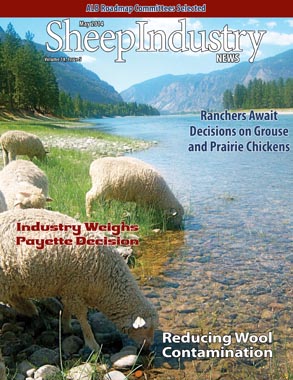
- May 2014
- President’s Notes
- Market Report
- Industry Weighs Payette Decision
- Producers Now Eligible for USDA Disaster Assistance
- ESA listing of Sage Grouse
- Parentage Test Could Benefit Sheep Producers
- Sheep Begin Fire Break Duties
- Don’t Let Your Farm be Fodder for Activists
- Reducing Contamination Vital to Wool Quality
- Data-Driven Approach
- ASI Awarded MAP, FMD Funding
- Obituaries
- Business Spotlight
- ASI News Briefs
- ALB Roadmap Committees Selected
Sheep Begin Fire Break Duties
About 750 Ewes and Lambs Provide Valuable Service in Nevada
Sean Whaley
Las Vegas Review-Journal
Hundreds of woolly four-footed fire suppression units, along with their bleating offspring, were unloaded into the hills west of the Nevada capital one day last month in what has become an annual program to reduce the risk of wildfires.
The 750 or so ewes and their lambs were to spend four weeks literally eating a firebreak between wildlands and urban areas as part of Carson City’s fire suppression efforts.
This is the ninth year of the program, which involves cooperation from private landowners, state officials, the city and the U.S. Forest Service. The sheep belong to the Borda Land and Sheep Co.
Ann Bollinger, natural resource specialist for the Carson City Parks and Recreation Department, displayed a photograph she took that demonstrated tangible results of the grazing program from past years.
The city has fenced off several small areas of the hillsides to allow for comparisons of vegetation growth. She showed a picture of one such enclosure, which had significantly more vegetation growing than the surrounding areas where the sheep have grazed now for nearly a decade.
The grazing program was initiated after the devastating 2004 Waterfall Fire, which started from a campfire up Kings Canyon to the west of the city. Before it was put out, the fire burned 8,000 acres and destroyed 18 homes.
The main focus of the grazing program is cheat grass, which dries out early and becomes a fire hazard, Bollinger said. Getting the invasive grass under control allows native grasses, which are more resistant to fire, to grow and expand, she said.
The animals were expected to consume about 4,000 pounds of fuel each day as they moved along the hills, accompanied by sheep herders and their dogs, Pyrenees and border collies.
Anna Belle Monti, a forester with the Forest Service, said a similar program was getting underway last month with 1,000 sheep in the Timberline Drive area of southwest Reno.
Outlying areas of Reno have seen their share of devastating wildfires as well over the past few years due in part to the severe drought conditions that persist this year as well in western Nevada. One of the worst was the Caughlin Ranch Fire in November 2011 that destroyed 30 homes.

